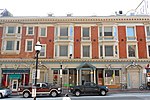Cathedral Hill Historic District (Baltimore, Maryland)

The Cathedral Hill Historic District is an area in Baltimore, Maryland. It lies in the northern part of Downtown just south of Mount Vernon. Roughly bounded by Saratoga Street, Park Avenue, Hamilton Street, and St. Paul Street, these 10 or so blocks contain some of the most significant buildings in Baltimore. The area takes its name from the Basilica of the Assumption which sits in the heart of the district. Despite the number of large religious structures in the area, the district's buildings are primarily commercial in character, with a broad collection of significant commercial structures ranging in date from 1790 to 1940.Cathedral Hill contains a mix of architectural styles from Georgian of St. Paul's Rectory to Art Deco along Charles Street. The area was added to the National Register of Historic Places in 1987. Cathedral Hill is within Baltimore National Heritage Area.
Excerpt from the Wikipedia article Cathedral Hill Historic District (Baltimore, Maryland) (License: CC BY-SA 3.0, Authors, Images).Cathedral Hill Historic District (Baltimore, Maryland)
West Pleasant Street, Baltimore Downtown
Geographical coordinates (GPS) Address Nearby Places Show on map
Geographical coordinates (GPS)
| Latitude | Longitude |
|---|---|
| N 39.293611111111 ° | E -76.616111111111 ° |
Address
West Pleasant Street
21201 Baltimore, Downtown
Maryland, United States
Open on Google Maps









